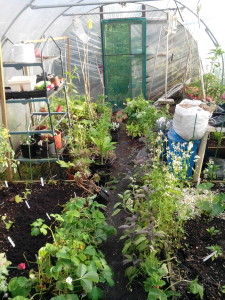Dr Who has his own time travelling Tardis and I think I have discovered a new way to manipulate time, polytunnel time. Let me explain.
 A polytunnel is a great thing. It delivers all year round. It provides space to store tender plants through the winter, a place to grow salads in February, and room to start off tender plants way before they would survive outside.
A polytunnel is a great thing. It delivers all year round. It provides space to store tender plants through the winter, a place to grow salads in February, and room to start off tender plants way before they would survive outside.
If you are not careful it can also provide a place to bake plants on a hot day and kill them off before your eyes.
But what of my title I hear you say, well here is my theory on polytunnel time.
Things that grow in a polytunnel seem to enter a different lifecycle. They grow quicker, but they also mature, go to seed and die quicker. A good example of this is that my polytunnel broad beans are already over. We had a few good dinners, and now they have finished. Meanwhile my outdoor broad beans are just beginning to form pods. They are at least 4 weeks behind, but then they will keep growing through to July, perhaps August, a much longer season.
The positive from this is that careful management and balancing crops, growing in and out of the polytunnel, means that you can dramatically extend the vegetable growing season.
The other side of the coin is that this also adds to the work involved. I estimate that for a given area it takes twice as much time to manage that land inside a polytunnel compared to the same area outside. For this you get perhaps 1 1/2 times as much produce. For example, today, I have cleared away the broad bean stems and have been adding compost ready to plant out brassicas and carrots tomorrow. More work, more food.
One thing I am not doing is complaining. I love growing vegetables, especially with the flexibility and the extra crops the polytunnel gives me. Where else could I pick rocket for a blue cheese and rocket wrap on a cold snowy February day, whilst also sowing the first radish seeds?
I guess I am just sharing an observation for prospective polytunnel owners. They are great, you won’t regret buying one, but watch closely, else you find a jungle growing in there.



 The first picture (top) shows the view of the polytunnel from the house. Broad beans are already providing some cover at a low level, with Jerusalem artichokes to the right. You can also see the overhanging square framework for the runner beans in place and showing in its outline how it will completely obscure the polytunnel.
The first picture (top) shows the view of the polytunnel from the house. Broad beans are already providing some cover at a low level, with Jerusalem artichokes to the right. You can also see the overhanging square framework for the runner beans in place and showing in its outline how it will completely obscure the polytunnel. In between the rows of beans you might be able to spot ground cover in the form of radishes for a quick crop, and vegetable squashes which will grow with the beans up the poles, adding to the screening and giving us squashes for the winter months.
In between the rows of beans you might be able to spot ground cover in the form of radishes for a quick crop, and vegetable squashes which will grow with the beans up the poles, adding to the screening and giving us squashes for the winter months.